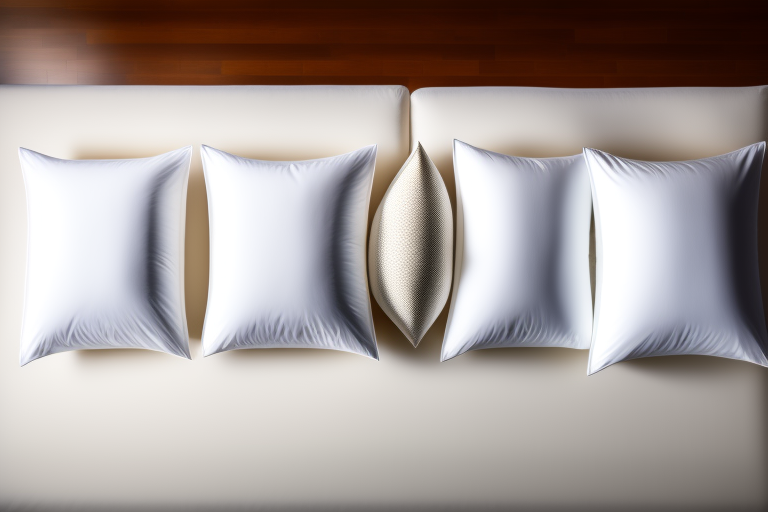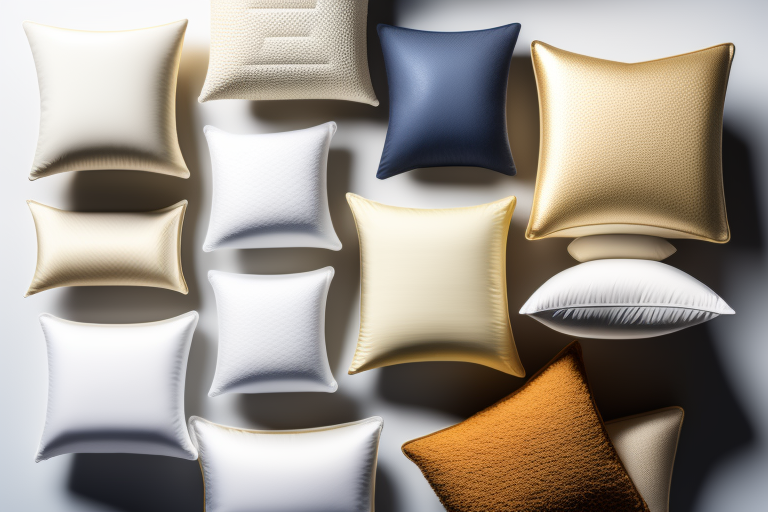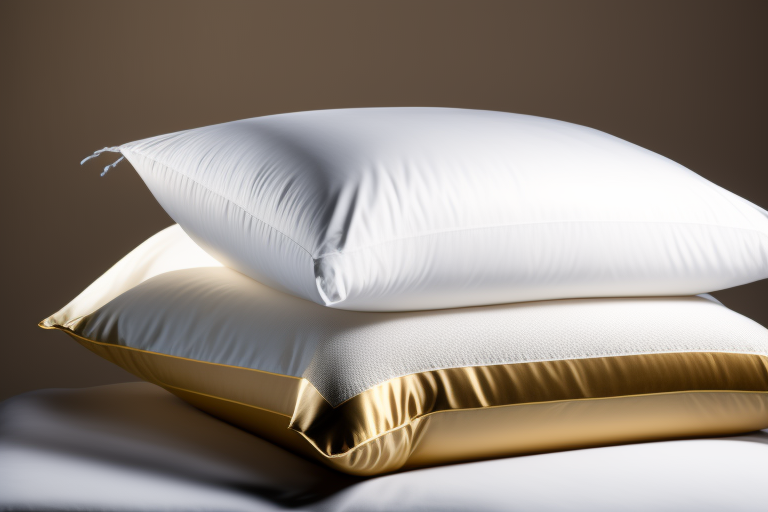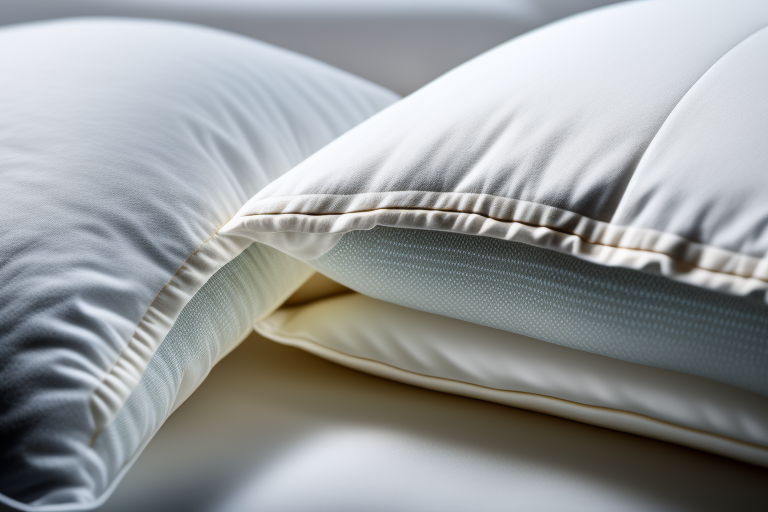Do you ever wonder what pillow Kim Kardashian rests her head on each night? With so many options to choose from, selecting the right pillow for your needs can be a daunting task. This comprehensive guide will walk you through the pros and cons of various pillow types, materials, sizes, and more to help you find your perfect match. Read on to learn insider tips and discover the pillow of your dreams!
An Introduction to Pillows
Before delving into specifics, let’s start with the basics – what exactly is a pillow? A pillow is a cushioned support for the head, neck or other parts of the body that provides comfort and aids sleep. The earliest pillows date back over 9,000 years to Mesopotamia when people stuffed leather bags with soft materials to elevate their heads. Today, pillows come in a wide array of shapes, sizes and fill materials to suit individual preferences.
Choosing the optimal pillow is critical for a good night’s rest. The right pillow aligns your head, neck and spine to minimize pressure points and reduce pain. It also enhances circulation and allows you to fully relax for deeper, more restorative sleep. On the other hand, the wrong pillow can lead to stiff necks, headaches, snoring and poor sleep. Considering we spend nearly a third of our lives sleeping, your pillow choice impacts your health and quality of life.
This comprehensive guide will overview the leading pillow options, benefits, drawbacks, prices and more to help you find your perfect match. Let’s get started!
The Top Pillow Types
With so many options on the market, deciding on the right pillow type can be confusing. Here we outline the most popular varieties along with pros and cons of each:
Memory Foam Pillow
Memory foam pillows contour to the shape of your head and neck while providing close conforming support. Benefits include:
- Mold to your neck and head shape
- Retain shape over time
- Provide optimal orthopedic support
- Alleviate pressure points
- Relieve neck and back pain
- Offer good motion isolation
Potential drawbacks include:
- Can feel too hot for some
- Produce an odor at first
- Are on the heavier side
- May be expensive
Down Pillow
Down pillows are stuffed with the soft, fluffy plumage from ducks or geese. Advantages include:
- Light, airy and breathable
- Provide soft, luxurious feel
- Easy to reshape and fluff
- Thermo-regulating and moisture wicking
- Long lasting if cared for properly
Some disadvantages are:
- Expensive
- Allergy/asthma triggers
- Flattens with use
- Requires fluffing to retain shape
- No conforming support
Latex Pillow
Latex pillows provide springy yet moldable support. Here are some upsides:
- Conform closely to head and neck
- Offer pressure relief
- Maintain shape well
- Sleep cool
- Hypoallergenic and antimicrobial
- Environmentally friendly material
Downsides can be:
- Heavy weight
- Distinct rubber odor
- Expensive price tag
- Not as cushy or soft
Buckwheat Pillow
Buckwheat pillows are filled with natural buckwheat hulls that conform to your contours. Pros:
- Mold perfectly to your shape
- Stay cool during sleep
- Adjustable fill levels
- Provide firm support
- Hypoallergenic
- Environmentally friendly
Some cons are:
- Makes crunchy noises when moving
- Can feel overly firm or hard
- Heavy
- Needs occasional hull refills
Water Pillow
As the name suggests, these pillows are filled with water that conforms to your head and neck. Benefits include:
- Fully adjustable firmness and height
- Distributes weight evenly
- Stays cool all night
- Hypoallergenic and mold resistant
- Supports proper neck alignment
Drawbacks can be:
- Chance of leaking
- Wave noise when moving
- Heavy and cumbersome
- Expensive
- Susceptible to temperature changes

What Pillow Size is Best?
Along with materials, pillow sizing plays a key role in determining comfort and support. Let’s compare the popular options:
Standard Size
At 20” x 26”, standard pillows are the smallest option. Pros:
- Well suited for petite frames
- Fit standard pillowcases
- Often the most affordable choice
- Good for stomach and back sleepers
Cons:
- Too small for broad shoulders
- Don’t offer enough support or surface area for most people
- Need frequent fluffing and reshaping
Queen Size
Queen pillows measure 20” x 30” for extra surface area and support. Benefits:
- Accommodate most people
- Ideal for side sleepers
- Provide ample cushioning and surface space
- Fit into queen pillow cases
- Offer good value for money
Limitations:
- Too large for smaller body frames
- Not long enough for very tall people
- Can be expensive if using premium materials
King Size
King pillows measure 20” x 36” for maximum comfort. Perks include:
- The longest surface space and width
- Best for broad shoulders
- Allow tall users to fully stretch out
- Provide excellent alignment support
- Ideal for combination sleepers
Negatives:
- Require oversized king pillowcases
- Too big for smaller people
- Need ample bed space to avoid crowding
- Most expensive option
Euro Pillow
Euro pillows measure 26” x 26” for a large square surface. Pros:
- Allow lying in any direction
- Good for changing positions
- Offer expansive surface area
- Fit square shams and cases
Cons:
- Big size requires ample bed space
- Too large for smaller frames
- Need Euro size pillow cases
- Provide less cervical support

Choosing the Right Pillow Material
Along with size, the outer material impacts the pillow’s properties. Here are top options:
Silk Pillowcase
Silk pillowcases feel ultra-smooth and soft. Benefits include:
- Reduce friction and pulling on skin and hair
- Help retain moisture
- Resist buildup of dirt, oils and allergens
- Allow skin to breath
- Easy to maintain and clean
Downsides:
- Expensive
- Wrinkle easily
- Delicate and prone to tearing
- Require dry cleaning
Satin Pillowcase
Satin has a smooth, lustrous surface. Pros:
- Gently glide against skin and hair
- Resist skin irritants, allergens and oils
- Affordable cost
- Durable and long-lasting
- Machine washable
Cons:
- Can snag more easily than silk
- Tends to wrinkle a lot
- Some find them overly slippery
- Can trap more heat
Organic Pillow
Organic pillows are filled with natural materials like latex, wool, cotton, etc. Benefits:
- Made with renewable natural materials
- Hypoallergenic and non-toxic
- Sustainable and ecologically friendly
- Naturally moisture wicking and breathable
- Biodegradable and recyclable
Limitations:
- More expensive than synthetic pillows
- Less selection and availability
- May wear down faster than synthetic fills
- Can be heavy, dense or firm
Hypoallergenic Pillow
Hypoallergenic pillows contain no allergens. Pros:
- Ideal for allergy and asthma sufferers
- Contain zero irritants or toxins
- Resist buildup of dust mites and allergens
- Often made of natural materials
- Reduce reactions and symptoms
Cons:
- Can be expensive
- Limited style and fill options
- Need regular replacement every 1-2 years
- May still trigger severe allergies
Must-Have Pillow Accessories
To optimize your pillow, consider these beneficial extras:
Pillow Protector
Pillow protectors create a barrier against sweat, oils, allergens and debris. Benefits:
- Promote hygienic sleep surface
- Extend pillow’s lifespan
- Safeguard against buildup and soiling
- Waterproof options block fluids
- Many are hypoallergenic
Potential negatives:
- Add extra layer between you and pillow
- Cheap versions are noisy and crinkle
- Need regular washing
Pillow Cover
A pillow cover provides a removable, washable outer case. Pros:
- Protect pillow from wear and tear
- Create smooth, uniform surface
- Easy to remove for washing
- Fun way to change decor
- Conceal damaged or old pillows
Cons:
- Extra layer between you and pillow
- Need regular cleaning
- Cheap ones pill and degrade over time
Pillow Sham
Shams slip over your pillow with openings in back. Benefits:
- Decorative accent for your bed
- Easily change the look of your bedding
- Protect pillows from sun damage
- Hide old or worn out pillows
- Create a polished, put together look
Limitations:
- Strictly decorative, not functional
- Require pillow inserts for structure
- Need frequent cleaning
- Costly for quality materials
Choosing a Pillow for Health Needs
Those with specific conditions require tailored pillow designs:
Neck Pain Relief Pillow
Orthopedic pillows provide ergonomic support for neck issues. Pros:
- Align the head, neck and shoulders
- Support the cervical curve
- Alleviate pinched nerves and muscle strain
- Relieve neck arthritis and injury pain
- Adapt to fit comfort preferences
Cons:
- Can take time to adjust to
- Improper fit worsens neck pain
- Not suitable for all sleeping positions
- Higher average price point
Cooling Pillow
Cooling pillows prevent overheating and night sweats. Benefits:
- Remain cool all night long
- Promote airflow and breathability
- Wick away moisture and heat
- Contour to body shape
- Ideal for hot sleepers and menopause
Some downsides:
- Make noise when moving head
- Less cradling comfort and support
- Need frequent reshaping
- More expensive than basic pillows
Orthopedic Support Pillow
Orthopedic pillows provide alignment for back and joint issues. Pros:
- Customizable heights and fills
- Align the spine and joints
- Relieve pressure on hips, knees and ankles
- Accommodate side, back and stomach sleepers
- Adaptable and adjustable firmness
Drawbacks:
- Trial and error to find ideal fill
- Improper use can make pain worse
- Not cheap
- Frequent reshaping needed

Choosing a Pillow for Specific Sleep Needs
Those with particular sleep issues should consider these options:
Pregnancy Pillow
Pregnancy pillows support expectant mothers through all trimesters and postpartum. Benefits:
- Full body support in any position
- Alleviate back, hip and joint pain
- Relieve pressure points
- Promote side sleeping alignment
- Adapt as belly grows
- Aid breastfeeding
Limitations:
- Bulky and space hogging
- Can get hot during sleep
- Only useful while pregnant
- Expensive for short term use
Body Pillow
Extra long body pillows allow full body hugging and alignment. Pros:
- Alleviate pressure along the full body
- Offer complete front and back support
- Promote proper spine alignment
- Adapt to your preferred sleep positions
- Provide a soothing sensation of being held
Cons:
- Take up a lot of bed space
- Can cause overheating
- Frustrating to wash and clean
- Flattening and indentation over time
Travel Pillow
Travel pillows provide cushioning and support on the go. Benefits:
- Portable and compact
- Support head, neck and chin
- Enable resting while travelling
- Conform closely for stability and comfort
- Adjust to fit different anatomies
Drawbacks:
- Bulky around neck and shoulders
- Offer minimal padding and contouring
- Cheap versions lack support and durability
- Strictly a temporary pillow solution
Caring for Your Pillow
To enjoy your pillow’s benefits, proper maintenance is key:
Pillow Filling Material
The interior filling impacts comfort, support, longevity and more. Common options include:
Memory foam – Retains shape but sleeps hot
Down feathers – Luxuriously soft but expensive
Polyester fibers – Affordable but loses loft
Latex – Conforms closely but heavy
Buckwheat hulls – Fully customizable but noisy
Choose an interior fill suited for your needs like cooling, neck support, affordability, etc.
Fluffing Your Pillow
Fluffing helps pillows retain their shape and plumpness. Tips:
- Fluff morning and night by kneading and shaking
- Use a clean tennis ball to fluff foam and fiber fills
- Add or remove fill like buckwheat to adjust height
- Replace old pillows that can’t be revived by fluffing
Fluff foam, down, fiber and buckwheat pillows regularly to restorecomfort.
Cleaning Your Pillow
Follow these tips to keep your pillow fresh and hygienic:
- Use a protective cover changed and washed weekly
- Spot clean stains immediately with gentle cleaner
- Check label instructions and wash in batches to balance
- Air out pillows in sunlight to kill dust mites and freshen
- Replace pillows every 1-2 years for cleanliness and support
Proper pillow cleaning promotes good sleep hygiene and health.
Conclusion: It’s Time to Upgrade Your Pillow for Better Rest
Hopefully this comprehensive guide provided you with the pillow knowledge to make an informed decision suited for your individual needs and preferences. The right pillow improves alignment, minimizes pain, enhances your sleep environment and supports overall wellbeing.
While the abundance of sizes, materials and options on the market makes selecting the ideal pillow overwhelming, you now have insights and tools to narrow your choices. Refer to the pillow comparisons and assessments whenever you need to replace an old, worn out pillow to refresh your sleep setup.
Frequently Asked Questions
What is the best pillow material for neck pain?
For neck pain relief, orthopedic memory foam and latex pillows provide the closest contouring support. The responsive cushioning aligns the head, neck and shoulders to minimize pressure points and reduce pain. Buckwheat and water pillows also adapt closely to the neck’s shape and positioning. Compare different orthopedic options to find your ideal firmness.
How do I choose the right pillow size?
Select your pillow size based on your body frame, sleep position and bed size. Petite frames suit standard size pillows. Queen size works for most people and all sleep positions. King size pillows best fit broad shoulders and tall users. Euro pillows allow you to switch sleep directions easily. Make sure to choose a size that fits your available mattress space.
What’s the best cooling pillow for hot sleepers?
If you frequently overheat at night, choose a cooling pillow designed with temperature regulating features like conductive fibers, gel infusion or special covers to pull heat away from your skin. Latex, buckwheat and water pillows also remain cooler than other fills like foam or down. For severe night sweats, opt for a phase change material (PCM) pillow that absorbs and releases heat.
How often should you replace your pillow?
Plan to replace pillows every 1 to 2 years, or sooner if they become misshapen, flat or fail to adequately support you. Memory foam, down and polyester pillows gradually lose their supportive loft so need more frequent replacement. Latex and buckwheat pillows last longer if cared for properly. Use a pillow protector and regularly fluff and reshape to extend your pillow’s lifespan.
What’s the best pillowcase material?
Silk and satin pillowcases feel ultra-smooth against skin and hair while resisting buildup of oils, allergens and skin irritants. Cotton pillowcases are affordable, breathable and machine washable. Linen boasts temperature regulating and moisture wicking properties. For severe allergies, try an antimicrobial bamboo or eucalyptus pillowcase to reduce allergens. Compare options to find your ideal blend of softness, benefits and easy care.








